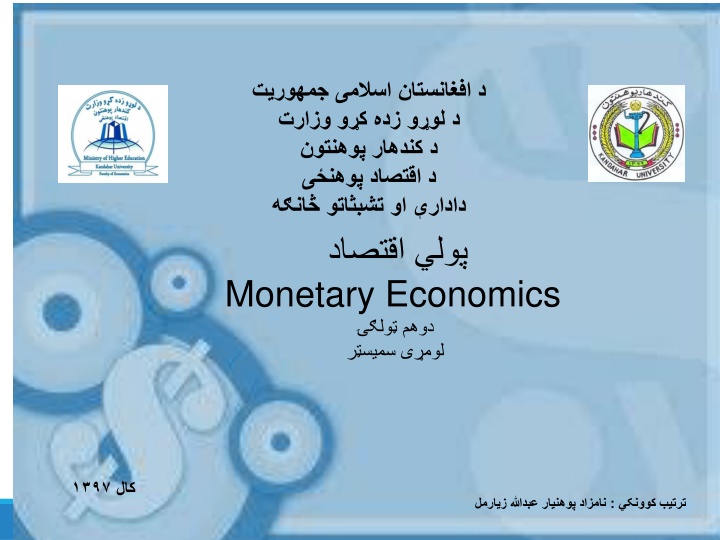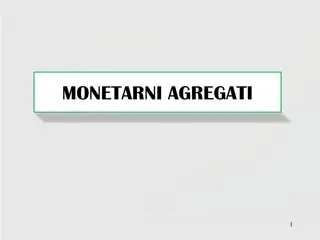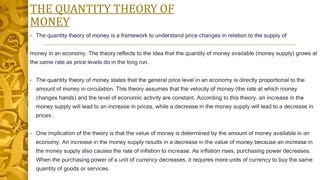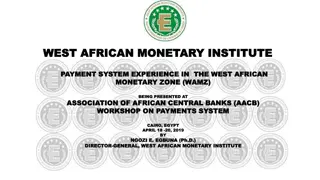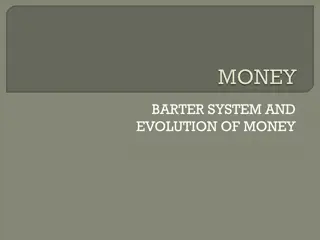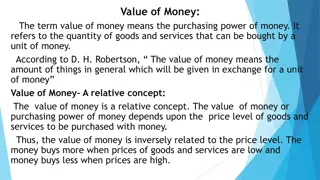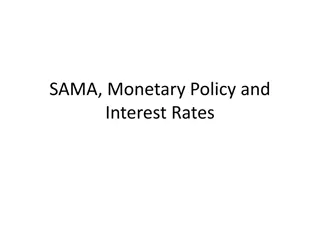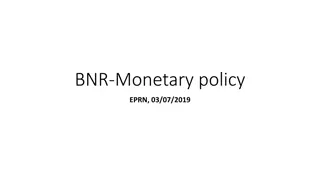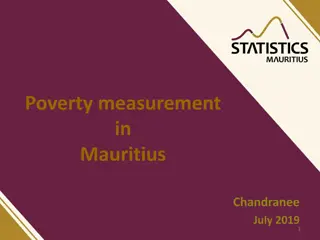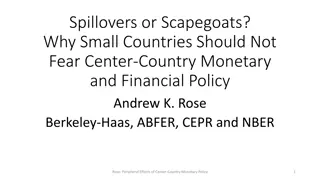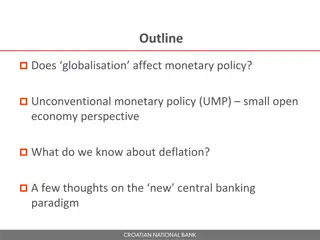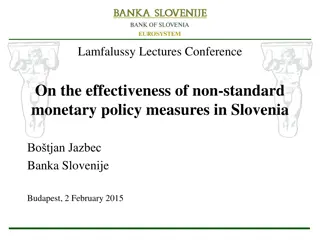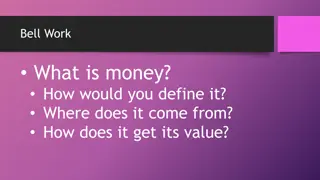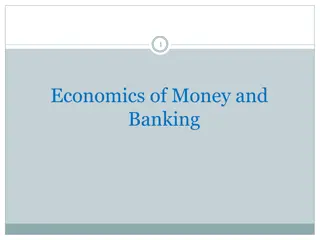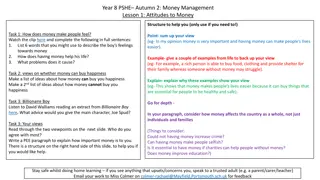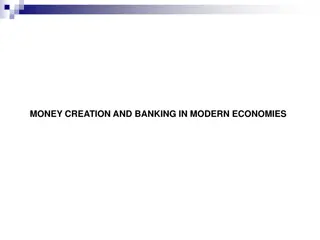Monetary Economics and the Meaning of Money
Monetary economics delves into the money supply, prices, interest rates, and their impacts on the economy. Explore the nature of money, its role in exchanges, and the connection between money, credit, and monetary policy. Discover the definition and significance of money as a medium of exchange, store of value, and unit of account.
Download Presentation

Please find below an Image/Link to download the presentation.
The content on the website is provided AS IS for your information and personal use only. It may not be sold, licensed, or shared on other websites without obtaining consent from the author.If you encounter any issues during the download, it is possible that the publisher has removed the file from their server.
You are allowed to download the files provided on this website for personal or commercial use, subject to the condition that they are used lawfully. All files are the property of their respective owners.
The content on the website is provided AS IS for your information and personal use only. It may not be sold, licensed, or shared on other websites without obtaining consent from the author.
E N D
Presentation Transcript
The Meaning of Money It is not any scarcity of gold and silver, but the difficulty which such people find in borrowing, and which their creditors find in getting payment, that occasions the general complaint of scarcity of money. Adam Smith, Wealth of Nations (1776) IV. I BY: ABDULLAH ZIARMAL
What you will learn in this chapter: The nature of monetary economics The meaning of 'money' in economics The importance of money in exchange The changing nature of money and its link with social change The relationship between money and credit The importance of credit The meaning of the 'transmission mechanism' of monetary policy BY: ABDULLAH ZIARMAL
The definition of monetary economics: Monetary economics is the economics of the money supply, prices and interest rates, and their repercussions on the economy. It focuses on the monetary and other financial markets, the determination of the interest rate, the extent to which these influence the behavior of the economic units and the implications of that influence in the macroeconomic context. It also studies the formulation of monetary policy, usually by the central bank or the monetary authority, with respect to the supply of money and manipulation of interest rates, in terms both of what is actually done and what would be optimal. . . BY: ABDULLAH ZIARMAL
WHAT IS MONEY ? money is mean of exchange/payments Store of value Unit of account BY: ABDULLAH ZIARMAL
Definition of money : . Descriptive definition : Legal definition : General acceptability definition: BY: ABDULLAH ZIARMAL
Descriptive definition : Crowther : Anything that is generally acceptable as a mean of Exchange Store And Measure Is money . : . BY: ABDULLAH ZIARMAL
Coul born Money is the mean of payment and valuation 2.Legal definition: . : : : BY: ABDULLAH ZIARMAL
Definition of money : . Descriptive definition : Legal definition : General acceptability definition: BY: ABDULLAH ZIARMAL
General acceptability definition DH,Roberston: money is anything that process general acceptability and acts as a mean of : Medium of exchange Unit of account Store of value Standard for deferred payments BY: ABDULLAH ZIARMAL
Narrow definition of money: Money : is that good which serves directly as a medium of payments. In financially developed economies, this role is performed by currency held by the public and the public s checkable deposits in financial institutions, mainly commercial banks, with their sum being assigned the symbol M1 . BY: ABDULLAH ZIARMAL
Broad definition of money the sum of currency in the hands of the public plus all of the public s deposits in commercial banks M2. M1 =Currency in the hands of the public checkable deposits in commercial banks. M2 =M1+savings deposits in commercial banks. BY: ABDULLAH ZIARMAL
Table 10.1 Composition of money supply Money supply Composition currency a. coins b. paper money demand deposits money deposit a. Savings deposit b. Time deposit deposits substitutes a. promissory notes b. commercial paper currency deposits of nonbank residents M1 or narrow money M2 or broad money M3 or total liquidity M4 BY: ABDULLAH ZIARMAL
Stages in Development of money Evolution of money : ) ( : Barter system Commodity money ) ( Paper money ) ( Metallic money ) ( Credit money ) ( Electronic money ) ( BY: ABDULLAH ZIARMAL
Barter System Trade by barter is the direct system and practice of exchanging goods and services for goods or services The best way to understand the importance of money in any economy is to look at an economy that does not use money. . BY: ABDULLAH ZIARMAL
: The difficulty of double co-incidence of wants It wastes time and energy, i.e. laborious and time-consuming; Lack of a common measure of value. The exchange always becomes uninteresting. BY: ABDULLAH ZIARMAL
It does not encourage deferred payments It does not encourage the system of division of labor and specialization; There is no lending and borrowing; It discourages large-scale production. Difficulty in storing value; Difficulty in transfer of wealth Difficulty of collecting tax ) ( BY: ABDULLAH ZIARMAL
(i) Metallic money : They are metal coins money with definite amount. (ii) Paper Money: It is in form of paper notes which originated from the receipts that the Goldsmiths issued to people. (iii) Bank Money: It is deposit in both Savings Account, Current Account and Fixed Deposit Account . : : . : . BY: ABDULLAH ZIARMAL
Foreign Money: It is the money of other countries and it serves as money in the foreign exchange market. Legal Tender money: It is money backed by the force of law in a country which is generally acceptable as a medium of exchange. . : . : BY: ABDULLAH ZIARMAL
Commodity Money: It is commodity used as money in the olden days, e.g. cowries, manila etc. Token Money: This is money whose intrinsic worth is less than its normal or face value. Representative Money: It is a document or lieu of legal tender but not fully and freely acceptable e.g. cheques, postal and money order bills, etc. : BY: ABDULLAH ZIARMAL
the characteristics of money (a) Homogeneity: Each unit of money must be homogenous, that is, each unit held by different individuals must be identical; (b) General Acceptability: Each unit of money must be generally acceptable in exchange for goods and services purchased; (c) Portability: Each money unit must be easily carried about. In other words, it must be easily transmissible . : . : . : BY: ABDULLAH ZIARMAL
(d) Divisibility: Money must be capable of being divided into small units; (e) Recognisibility: Money must be easily recognizable by all and sundry in order to detect any counterfeit; (f) Scarcity: Money must be relatively scarce in order to maintain its value. (g) Stability in Value: There should be absence of inflation and deflation to make money stable in value as well as enable it serve some useful functions such as the store of value and means of deferred payment; . . : : : . . : BY: ABDULLAH ZIARMAL
functions of money Primary functions: (a) Money serves as a medium of exchange. With the introduction of money, goods and services are exchanged with money and thus exchange is facilitated. With money as a mean of exchange, the problems of barter are bye-passed. (b) Money serves as a unit of account. All business transactions are accounted in one units. Whether it is payments, debts or costs, it is made in money units. This facilitates exchange or transactions. (c) Money serves as a measure of value. With money, one can measure the quality or value of goods, services or different occupations BY: ABDULLAH ZIARMAL
Secondary functions: (a) Money serves as a standard for deferred payments - With the use of money, one can postpone or defer the payment for goods and services purchased. This function is important these days when business transactions are carried out mostly on credit basis. (b) Money serves as a store of value. In-so-far as there is no inflation and deflation in the economy, money serves as a store of value since money would not lose its value any period it is kept. (c) Money serve as a transfer of value: since money is a generally acceptable means of payment and acts as a store of value. Aid to Specialization, production and trade Influence on income and consumption :Money is an instrument of making loan Money as a tool of monetary management Instruments of economic policy BY: ABDULLAH ZIARMAL
Contingent functions: Money also performs certain contingent or incidental functions such as (a) Money as the most liquid of all liquid assets - Money as the most liquid of all liquid assets in which wealth is held. Individuals and firms may hold wealth in infinitely varied forms. (b) Basis for the credit system - Money is the basis of credit system. Business transactions are either in cash or on credit. Distribution of national income Measure of marginal productivity Liquidity of property BY: ABDULLAH ZIARMAL
Demand for money the following are the three types of demand: ( ) The demand for money refers to holding on with your money and : 1. Transaction Motive demand The desire to keep or hold money for the day-to-day transactions. Lt=(K*Y). Lt = f(Y) . 2. Precautionary Motive demand people often demand money as a precaution against an uncertain future. Unexpected expenses, such as medical or car repair bills, often require immediate payment.M1=L1(Y*r) . BY: ABDULLAH ZIARMAL
Speculative motive of demand Speculative Motive: People also keep money with the hope of using such money kept in making quick money V=R/r. this is influenced by interest rates. . . Where V is the current market value of a bond, R is the annual return on the bond, and r is the rate of return currently earned or the market rate of interest. So a bond worth Rs 100 (V) and carrying a 4 per cent rate of interest (r), gets an annual return (R) of Rs 4, that is, V=Rs4/0.04=Rs 100. When the market rate of interest rises to 8 per cent, then V=Rs 4/0.08=Rs50; when it fall to 2 per cent, then V=Rs 4/0.02=Rs 200. BY: ABDULLAH ZIARMAL
Money in the microeconomics The Microeconomics part of Monetary Economics focuses on the study of the Demand and Supply of money and their Equilibrium. : The institutions supplying the main components of the money stock are the central bank and the commercial banks. The commercial banks are themselves part of the wider system of financial intermediaries, which determine the supply of some of the components of money as well as the substitutes for money, also known as near-monies. BY: ABDULLAH ZIARMAL
Money in the Macroeconomics The Macroeconomics part of Monetary Economics is closely integrated into the standard Short- run macroeconomic theory. . The major macroeconomic variables in the short run. National output and employment, the rate of unemployment, Exports and imports, Exchange rates The balance of payments. BY: ABDULLAH ZIARMAL
The role of money Role of money in capitalist economy: Money is the sovereign queen of all delights, for her the teacher teaches, the lawyer pleads, the dancer dances the soldier fights. In capitalistic economy money is the pivot around which all economic activities cluster, money is an indicator as well as a surveyor of wealth, the importance of money can be judged from the powerful influence which it exercises on the : Volume of the production Direction of the production Pattern of consumption BY: ABDULLAH ZIARMAL
Con Method of distribution Direction and volume of exchange Rate of saving and interest Money in the field of public finance Attainment of high level of production and employment Money in the sphere of banking BY: ABDULLAH ZIARMAL
The operation of monetary economy: The circular flow of money income shown here give us the picture of here importance of money in the money using economy: BY: ABDULLAH ZIARMAL
TUTOR-MARKED ASSIGNMENTS (1)In your own words, give a functional definition of money. (2)Discuss the various types of money. (3)What are the functions of money? Describe clearly how money performs these functions. (4)What are its main characteristics and major roles in the economy of a Nation. (5)(The inadequacies of Trade by Barter as an Exchange Mechanism gave birth to money. Name and explain these inadequacies. (6)How does the use of money promote efficient production? BY: ABDULLAH ZIARMAL
